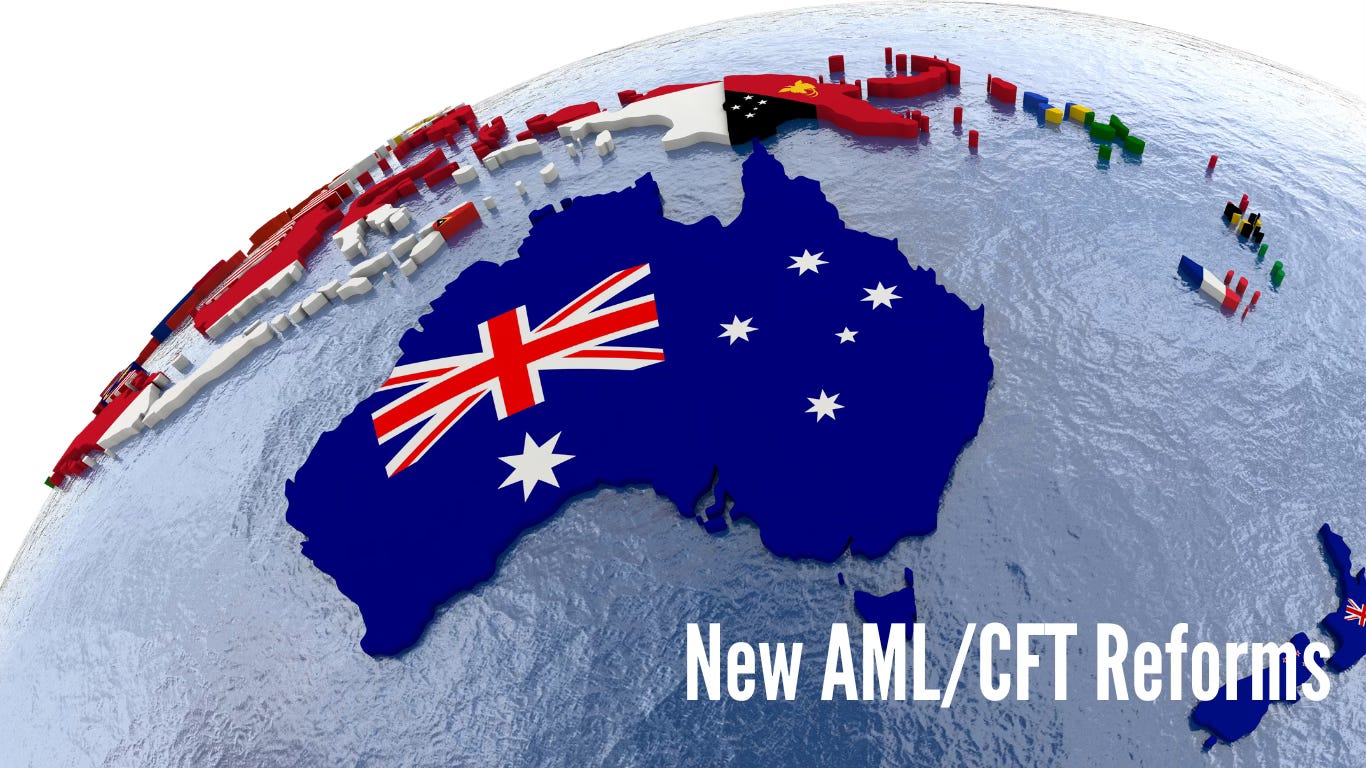Compliance in Fintech vs. Traditional Banking: Key Differences AML Professionals Should Know | AML/CFT Reforms in Australia and more
Welcome to our AML News and Updates Newsletter October 2024 edition. 👏
Stay up to date with main AML news and updates in less than 10 minutes per month!
This newsletter is sponsored by OMNIO – your all-in-one compliance software.
OMNIO automates key tasks like AML, KYC, and transaction monitoring, using cutting-edge machine learning to identify risks and provide recommendations in real time.
Our mission is to provide high-quality, user-friendly compliance solutions AT A VERY AFFORDABLE PRICE
Because compliance doesn’t have to be expensive!
Let's see an outline of the topics to be covered in this edition:
Discussion of the month: Compliance in Fintech vs. Traditional Banking: Key Differences AML Professionals Should Know
Regulatory Developments:
· AML/CFT Reforms in Australia
· EU Briefing Providing Analysis of CBI and RBI Programs
· China Will Strengthen Monitoring of New Money Laundering Risks
· New AML Obligations for Mortgage Professionals in Canada
Other News:
· FCA fines Starling Bank £29m for failings in their financial crime systems and controls
· Banque Audi (Suisse) Fined for Money Laundering Violations
· Danske Bank Settles Final Money Laundering Probe with France
Let's start...
Compliance in Fintech vs. Traditional Banking: Key Differences AML Professionals Should Know
Fintech, short for financial technology, refers to the use of innovative technology to provide financial services. Fintech companies aim to improve how we manage money, offering faster, more accessible, and efficient alternatives to traditional banking. Instead of relying on traditional physical banks, fintech enables people to access a wide range of financial services entirely online, often from their mobile devices or computers.
Types of Fintech
Fintech covers a broad range of services and sectors, each focused on improving or automating aspects of financial services. Here are the most common types of fintech:
Digital Payments: This includes mobile payment platforms and digital wallets that allow users to transfer money, pay bills, or make purchases instantly and conveniently.
Cryptocurrency Platforms: Fintech companies that facilitate the buying, selling, and storing of digital currencies like Bitcoin and Ethereum. Blockchain technology, often integrated with these platforms, offers secure, decentralized transactions.
Online Lending and Credit: Fintechs offering online lending platforms often provide faster loan approvals and more flexible credit options compared to traditional banks. These platforms usually involve less paperwork and can serve a wider range of customers.
Insurance Tech (Insurtech): These companies focus on simplifying the insurance process by using technology to make policy purchasing, claims, and management more automated and accessible.
Investment Platforms: Fintech has also made investing more user-friendly, allowing people to manage their portfolios online, invest in stocks, or receive automated advice on financial planning through robo-advisors.
Key Differences Between Fintech and Traditional Banking
While fintech and traditional banking offer similar financial services, their approaches differ significantly in the following ways:
Accessibility and Convenience: Fintech services are typically accessible from anywhere, providing financial solutions through apps or online platforms. Traditional banks often rely on physical branches and require more in-person interactions, although many have started offering digital banking services to compete with fintech.
Speed and Efficiency: Fintech companies prioritize speed, often providing instant loan approvals, same-day payments, and automated investment advice. Traditional banks, on the other hand, tend to have slower processes that involve manual reviews, longer wait times, and more paperwork.
Innovation and Flexibility: Fintechs are designed to be flexible, quickly adopting new technologies like artificial intelligence (AI), blockchain, and machine learning to improve customer experiences. Traditional banks, bound by legacy systems, usually adapt slower to these innovations.
Customer Focus: Fintechs are built with a strong customer-centric approach, offering personalized services and user-friendly interfaces. Traditional banks, while improving, generally offer a more standardized approach, though this is changing as they compete with fintech innovations.
Compliance Measures: Fintech vs. Traditional Banks
While fintech companies and traditional banks both need to comply with regulations, their approaches to implementing compliance measures often differ due to the nature of their operations in the following ways:
Risk Assessment
Fintech: Fintechs face risks related to the use of digital channels including cross-border transactions which results to a higher exposure to cyber threats and identity fraud. Additionally, some fintechs offer services related to crypto which expose them to additional risks due to their pseudonymity. All these risks must be considered in the risk assessment of every fintech.
Traditional Banks: Traditional banks tend to face risks tied to more complex customer profiles, larger institutional clients, and legacy systems. Their compliance teams, however, benefit from decades of experience in identifying and mitigating risks, particularly those related to money laundering and terrorist financing.
Customer Due Diligence (CDD) and Onboarding
Fintech: Fintech companies use digital tools for CDD, relying on electronic identity verification, biometric checks, and real-time verification methods. These processes are designed to minimize friction while ensuring compliance with Know Your Customer (KYC) obligations. However, fintechs need to be particularly cautious about ensuring compliance with data protection regulations like the General Data Protection Regulation (GDPR).
Traditional Banks: Traditional banks typically have more comprehensive CDD processes that include in-person document verification. This slower, manual process offers a higher level of certainty in identity verification but may create obstackles in customer onboarding.
Risk Management and Transaction Monitoring
Fintech: Real-time transaction monitoring is commonly used in fintech, often driven by machine learning algorithms that analyze transaction patterns for unusual activity. However, fintechs often lack the deeper expertise and experience in identifying complex criminal behaviors compared to traditional banks.
Traditional Banks: Banks typically have more established and robust transaction monitoring frameworks, benefiting from decades of regulatory experience. These systems are often more thorough and supported by large compliance teams that understand the challenges of financial crime and have stronger detection capabilities.
Reporting and Record-Keeping
Fintech: Given their digital nature, fintech companies tend to use cloud-based systems for reporting and record-keeping, ensuring customer data and transaction histories are stored securely for the required period. Regular audits are necessary to ensure compliance with local laws, particularly in data privacy and security.
Traditional Banks: Banks, due to their larger scale and established history, have more extensive record-keeping requirements and generally use secure, internal servers to store data. They must comply with strict regulatory mandates, often retaining data for longer periods to meet legal and audit standards.
Conclusion
While fintechs provide more innovative, accessible, and customer-friendly services than traditional banks, they face unique challenges, especially in maintaining compliance. Digital onboarding, real-time transaction monitoring, and data communication across systems are vital for fintech companies to stay ahead of risks like fraud and money laundering.
To succeed, both fintechs and traditional banks must focus on robust compliance measures while adjusting to an ever-evolving regulatory landscape.
AML/CFT Reforms in Australia
On 11 September 2024, the Australian Attorney-General introduced the Anti-Money Laundering and Counter-Terrorism Financing Amendment Bill 2024 to Parliament. This Bill seeks to address regulatory gaps, streamline, and modernize Australia's existing AML/CTF framework, aligning it more closely with the international standards set by the Financial Action Task Force (FATF). The reforms will bring "tranche two" sectors—such as legal professionals, accountants, real estate agents, and precious metals dealers—under the AML/CTF regime for the first time.
EU Briefing Providing Analysis of CBI and RBI Programs
The European Parliament issued a briefing which provides a comprehensive analysis of Citizenship by Investment (CBI) and Residence by Investment (RBI) schemes within the European Union (EU). These programs allow individuals from non-EU countries to obtain residence or citizenship in exchange for financial contributions, often referred to as "golden passports" and "golden visas." The briefing explores the growing concerns these schemes raise, such as risks to security, financial integrity, and the erosion of core EU principles. It also outlines the actions taken by the European Parliament and the European Commission to address these issues, including legislative proposals and legal challenges.
China Will Strengthen Monitoring of New Money Laundering Risks
China is moving to strengthen its monitoring of new money laundering risks posed by emerging technologies: According to Wang Xiang, a senior legislator, a draft amendment to the Anti-Money Laundering Law aims to address challenges brought by digital platforms, virtual currencies, and other new sectors. The amendment calls for enhanced monitoring systems, guidelines for emerging industries, and proportionate risk mitigation by financial institutions. It also prioritizes data security and privacy.
New AML Obligations for Mortgage Professionals in Canada
Starting October 11, 2024, mortgage professionals, including administrators, brokers, and lenders, will be required to report specific types of financial transactions—such as suspicious transaction reports, large cash transaction reports, large virtual currency transaction reports, and terrorist property reports —keep thorough records, identify clients through "Know Your Client" procedures, and adhere to ministerial directives.
FCA fines Starling Bank £29m for failings in their financial crime systems and controls
The fine was imposed for significant financial crime failings, particularly around financial sanctions screening. As the bank rapidly grew from 43,000 to 3.6 million customers between 2017 and 2023, its anti-money laundering controls failed to keep up. Starling opened over 54,000 accounts for high-risk customers, despite being restricted from doing so. Additionally, an internal review revealed that since 2017, Starling’s system only partially screened customers against financial sanctions lists, exposing gaps in its controls.
Banque Audi (Suisse) Fined for Money Laundering Violations
FINMA, the Swiss AML regulator, found Banque Audi (Suisse) SA in serious violation of anti-money laundering laws, including failure to disclose key internal audit reports and inadequate investigation of high-risk transactions involving politically exposed persons (PEPs). The bank failed to report suspicious activities and breached its duty to provide information, leading to fines and sanctions totaling CHF 22.9 million.
Danske Bank Settles Final Money Laundering Probe with France
Danske Bank has settled with French authorities, ending the last probe into suspected money laundering at its former Estonian branch. The bank will pay €6.33 million ($7 million), following previous settlements, including over $2 billion in the U.S. This concludes all investigations related to the bank's non-resident portfolio in Estonia.
Found this Newsletter useful?
Share it with other people to spread awareness!
Have a nice rest of the month!
Regards
Anna Stylianou
Founder AML Cube Consulting and Education










